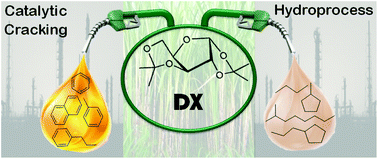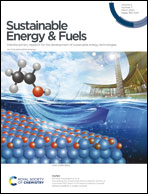Sugar ketals as a platform molecule to overcome the limitation of converting biomass into green-hydrocarbons in a typical refinery†
Abstract
Green-hydrocarbon production from second-generation biomass is a powerful approach to shortening the path to sustainable energy. Unfortunately, the properties of biomass are not suitable for refinery conditions. One key to this goal is to redesign the second-generation biomass into a stable and dense bio-crude based on sugar ketal derivatives. Herein, we carry out the conversion of a representative compound of this bio-crude, 1,2:3,5-di-O-isopropylidene-α-D-xylofuranose (DX), by two processes; typically carried out in oil refinery. Mixtures of DX of up to 70 wt% in n-hexane were converted by fluidized catalytic cracking (FCC) and 14.3 wt% of DX in n-hexane was converted by the hydroconversion process (HDC). FCC produced mainly mono-aromatics, whereas HDC yielded mainly saturated and naphthenic hydrocarbons containing more than seven carbons (formed exclusively from DX). These green hydrocarbons could be used as gasoline, diesel and jet fuel. Both processes efficiently converted green carbon and hydrogen from DX into hydrocarbons, ≈66% and 85%, respectively. Finally, these processes could be combined for producing green fuel and petrochemicals independent of an external non-renewable carbon source or used as model catalytic tests to improve the conversion of the bio-crude mentioned above.



 Please wait while we load your content...
Please wait while we load your content...